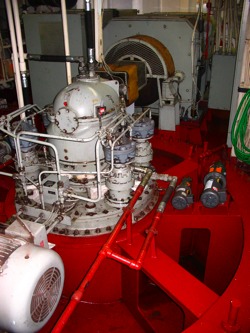FeMO3 Dive Cruise 2008
Report Day 16 -- Tuesday 7 October 2008 -- Engines, Propulsion, Electrical Generation, Water Making and More
FeMO3 Dive Cruise 2008 |
| Daily Reports 1 | 2 | 3 | 4 | 5 | 6 | 7 | 8 | 9 | 10 | 11 | 12 | 13 | 14 | 15 | 16 | 17 | 18 |

Terry Anderson is the Chief Engineer of the R/V Thomas G. Thompson. He is in charge of engines and propulsion, electrical generation, water making, air conditioning and sewage disposal on the ship. If something goes wrong mechanically it is his job to get it repaired. Several student questions inspired me to ask Terry for a tour of the engineering spaces on the Thompson.

The R/V Thompson is propelled by 3 diesel generator sets that drive two 3,000 hp electric motors. The electric motors each drive a propeller at the stern. The propellers are mounted on rotating drive units that can turn 360 degrees. The drive units look something like the lower unit of an outboard motor. Because the drive units rotate the Thompson does not need rudders – the drive units rotate and the ship changes direction. There is also a bow thruster, similar to having another propeller at the bow. This also rotates. The two stern propellers and the bow thruster are computer controlled and can all rotate 360 degrees independently of each other. This is a great advantage when maneuvering slowly (like docking) because the ship does not need to be moving to steer. Most ships have rudders and need to be moving through the water to steer.
This ability to steer the ship without moving forward is essential for scientists. Much oceanographic work is done with the ship attempting to stay over a particular patch of the bottom of the ocean so that instruments and tools (such as Jason and Medea) can be lowered to a particular spot. The ship must stay motionless despite winds and currents and waves that tend to push the ship away. The constant position is held by a computer that causes the propellers and bow thrusters to work together. The computer gets a GPS satellite signal and then it rotates the propeller drives to keep the ship on that position. The ability to stay in position by steering the thrust from the propellers is called Dynamic Positioning.

Most ships with dynamic positioning ability are research vessels or ships designed to service and repair off shore oil platforms. The repair of oil platforms in deep water requires lots of underwater work; as a result the oil industry is probably the largest user of ROVs like Jason. When hurricanes like Katrina and Ike blow through the Gulf of Mexico, it is ROVs that do much of the underwater repair work.
Terry reports there are lots of jobs available to graduates of maritime academies such the California Maritime Academy, the United States Merchant Marine Academy and Seattle Central’s Seattle Maritime Academy.
| FeMO3 Cruise Home Page |